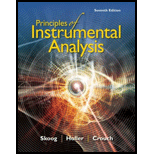
Principles of Instrumental Analysis
7th Edition
ISBN: 9781305577213
Author: Douglas A. Skoog, F. James Holler, Stanley R. Crouch
Publisher: Cengage Learning
expand_more
expand_more
format_list_bulleted
Concept explainers
Question
Chapter 13, Problem 13.6QAP
Interpretation Introduction
Interpretation:
The molar absorptivity of a solution containing
Concept introduction:
The molar absorptivity of a solution is defined as the capacity of a solution to absorb the particular
Now, the relation between the molar absorptivity, absorbance and concentration of the solution is given by the relation.
Expert Solution & Answer
Trending nowThis is a popular solution!

Students have asked these similar questions
5. A buffer consists of 0.45 M NH, and 0.25 M NH-CI (PK of NH 474) Calculate the pH of the butter. Ans: 9.52
BAS
PH-9.26 +10g (10.95))
14-4.59
PH=4.52
6. To 500 ml of the buffer on #5 a 0.20 g of sample of NaOH was added
a Write the net ionic equation for the reaction which occurs
b. Should the pH of the solution increase or decrease sightly?
Calculate the pH of the buffer after the addition Ans: 9.54
Explain the inductive effect (+I and -I) in benzene derivatives.
The inductive effect (+I and -I) in benzene derivatives, does it guide ortho, meta or para?
Chapter 13 Solutions
Principles of Instrumental Analysis
Ch. 13 - Prob. 13.1QAPCh. 13 - Prob. 13.2QAPCh. 13 - Prob. 13.3QAPCh. 13 - Prob. 13.4QAPCh. 13 - Prob. 13.5QAPCh. 13 - Prob. 13.6QAPCh. 13 - Prob. 13.7QAPCh. 13 - At 580 nm, which is the wavelength of its maximum...Ch. 13 - Prob. 13.9QAPCh. 13 - Zinc(II) and the ligand L form a 1:1 complex that...
Ch. 13 - The equilibrium constant for the conjugate...Ch. 13 - The equilibrium constant for the reaction...Ch. 13 - Prob. 13.13QAPCh. 13 - Prob. 13.14QAPCh. 13 - Prob. 13.15QAPCh. 13 - Prob. 13.16QAPCh. 13 - Prob. 13.17QAPCh. 13 - Prob. 13.18QAPCh. 13 - Prob. 13.19QAPCh. 13 - Prob. 13.20QAPCh. 13 - Prob. 13.21QAPCh. 13 - Prob. 13.22QAPCh. 13 - Prob. 13.23QAPCh. 13 - Prob. 13.24QAPCh. 13 - Prob. 13.25QAPCh. 13 - Prob. 13.26QAPCh. 13 - Prob. 13.27QAP
Knowledge Booster
Learn more about
Need a deep-dive on the concept behind this application? Look no further. Learn more about this topic, chemistry and related others by exploring similar questions and additional content below.Similar questions
- 19.57 Using one of the reactions in this chapter, give the correct starting material (A-L) needed to produce each structure (a-f). Name the type of reaction used. (b) ہ مرد (d) HO (c) དང་ ་་ཡིན་ད་དང་ (f) HO Br B D of oli H J Br K C 人 ↑arrow_forwardInductive effect (+I and -I) in benzene derivatives.arrow_forward7. Helparrow_forward
arrow_back_ios
SEE MORE QUESTIONS
arrow_forward_ios
Recommended textbooks for you
 Principles of Instrumental AnalysisChemistryISBN:9781305577213Author:Douglas A. Skoog, F. James Holler, Stanley R. CrouchPublisher:Cengage Learning
Principles of Instrumental AnalysisChemistryISBN:9781305577213Author:Douglas A. Skoog, F. James Holler, Stanley R. CrouchPublisher:Cengage Learning Principles of Modern ChemistryChemistryISBN:9781305079113Author:David W. Oxtoby, H. Pat Gillis, Laurie J. ButlerPublisher:Cengage Learning
Principles of Modern ChemistryChemistryISBN:9781305079113Author:David W. Oxtoby, H. Pat Gillis, Laurie J. ButlerPublisher:Cengage Learning Macroscale and Microscale Organic ExperimentsChemistryISBN:9781305577190Author:Kenneth L. Williamson, Katherine M. MastersPublisher:Brooks Cole
Macroscale and Microscale Organic ExperimentsChemistryISBN:9781305577190Author:Kenneth L. Williamson, Katherine M. MastersPublisher:Brooks Cole


Principles of Instrumental Analysis
Chemistry
ISBN:9781305577213
Author:Douglas A. Skoog, F. James Holler, Stanley R. Crouch
Publisher:Cengage Learning

Principles of Modern Chemistry
Chemistry
ISBN:9781305079113
Author:David W. Oxtoby, H. Pat Gillis, Laurie J. Butler
Publisher:Cengage Learning

Macroscale and Microscale Organic Experiments
Chemistry
ISBN:9781305577190
Author:Kenneth L. Williamson, Katherine M. Masters
Publisher:Brooks Cole